Bishan-Ang Mo Kio Park
Bishan-Ang Mo Kio Park (formerly known as Bishan Park) is a major park in Singapore, located in the popular heartland of Bishan. Serving the residents of Bishan and Ang Mo Kio, the park sits entirely within Bishan, running along the Ang Mo Kio–Bishan boundary line, which is situated at Ang Mo Kio Avenue 1.[1] In the middle of the park lies the Kallang River, which runs through it in the form of a flat riverbed.
| Bishan-Ang Mo Kio Park | |
|---|---|
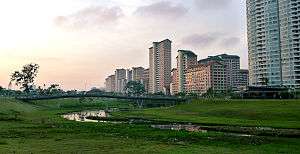 Bishan-Ang Mo Kio Park at sunset, with the Kallang River in the foreground. | |
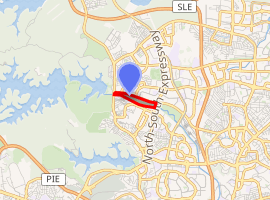
| |
| Type | Neighbourhood park |
| Location | Bishan, Singapore |
| Coordinates | 1°22′N 103°50′E |
| Created | 1988 |
| Operated by | National Parks Board |
| Status | Opened |
History
Bishan Park was constructed to provide a buffer between Ang Mo Kio New Town and Bishan New Town. It was also envisioned as a leisure destination for residents ranging from children to nature-lovers,[2] containing facilities such as a football field, a floating amphitheatre and a natural pond.[3] Construction took place in two stages.[2] The park, which cost $8.5 million to build, was one of the biggest park projects by the Housing Development Board at the time of its construction.[3] Before construction work was completed, people from the adjacent areas began using the unfinished facilities, making work on the park difficult.[4]
Redevelopment
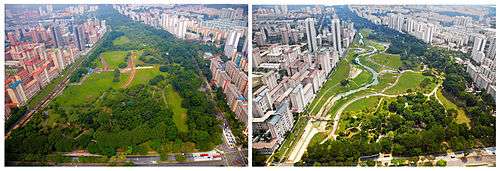
Background
The Active, Beautiful, Clean Waters (ABC Waters) Programme was launched in 2006 to transform the country’s water bodies beyond their functions of drainage and water supply into beautiful and clean rivers and lakes with new spaces for community bonding and recreation. At the same time, it promotes the application of a new, water-sensitive urban design approach (also known as ABC Waters design features in Singapore) to managing rainwater sustainably. A long-term initiative, over 100 locations have been identified for project implementation in phases by 2030, with 20 projects already completed, bringing people closer to water. ABC Waters Kallang River @ Bishan-Ang Mo Kio Park is one of the flagship projects under this programme. The park was due for major refurbishment and the Kallang River in the form of a concrete channel along the park edges was also due for upgrading to cater to increased rainwater runoff from the catchment due to urbanisation. Plans were thus made to carry out redevelopment works together, transforming Kallang River from a linear utilitarian concrete drainage channel into a meandering, natural river through the park.
Design process
The integration of the river and park involved joint responsibilities between government agencies in charge of different areas (parks and water). National water agency, PUB, and NParks engaged Ramboll Studio Dreiseitl (design) and CH2M Hill (engineering) to look at how the park, river and surrounding residential estates could be integrated as one. This took place through a series of workshops, on-site tours and discussions where issues were thrown out and ideas were exchanged and debated. The suitability of plant species for soil bioengineering, for example, had not been implemented in Singapore prior to this, and thus had to be tested – this was done through a year-long survey at the test reach (see Techniques). Other parties which came on board included bioengineering specialists and horticulturists
Techniques
Soil bioengineering
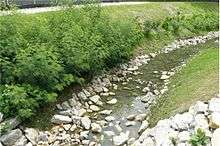
The use of soil bioengineering techniques (a combination of vegetation, natural materials and civil engineering techniques) to stabilize the river banks and prevent erosion was a first for Singapore and is a new reference for soil stabilisation in the tropics, which have otherwise rarely been used or documented. In 2009, a test bed was constructed, testing about 10 different soil bioengineering techniques and a wide variety of tropical plant species along a length of 60 metres at one of the side drains in the park. Seven of these techniques were then selected for use along the main river. These include fascines, rip-rap with cuttings, geotextile wrapped soil-lifts, brush mattresses with fascines, reed rolls, planted gabions, and geotextile with plantings. The test bed was used to refine the selection of appropriate techniques and plants, as well as the most efficient and effective construction methods. Extensive systematic testing was carried out, including measuring the depth and tenacity of root development.
Cleansing biotope

Cleansing biotopes offer effective water treatment while maintaining a natural and beautiful environment. They consist of carefully selected plants in a filter medium which helps to cleanse the water by filtering pollutants and absorbing nutrients. Located upstream in the park, the cleansing biotope helps to maintain the water quality of the ponds without the use of chemicals.
Within the park, a new water playground was designed to increase the attractiveness and visitor enjoyment of the park. Water for this playground is supplied by cleansed pond water that has been filtered through the cleansing biotope and has undergone an ultraviolet (UV) treatment to eliminate any harmful biological contaminants without introducing any chemicals into the water.
Park features
Three new playgrounds were constructed for children to enjoy. New bridges, stepping stones in the water and a riverside gallery were also built to encourage increased interaction with water. Existing features such as the foot reflexology feature, community garden, dog run and fitness areas were refurbished to update the overall look of the park.
 The Bubble Playground
The Bubble Playground One of the three turrets in the Adventure Playground
One of the three turrets in the Adventure Playground- New grass planting at the foot reflexology
Biodiversity
No wildlife was introduced to the park but the introduction of the naturalised river into the park has seen the park’s biodiversity increase by 30%. Singapore lies within the East Asian – Australasian Flyway so the park can expect to receive some special migratory bird visitors. A few surprise visitors have been spotted including the Zanzibar red bishop, a native to Africa, the spotted wood owl, native to the jungle forest in Indonesia, long-tailed parakeet, native in the Andaman Islands and the orange-cheeked waxbill, native to western and central Africa. Birds such as the purple heron, scaly-breasted munia and white-breasted waterhen that are seldom seen in a high-dense urban neighbourhood have also been spotted roosting among the vegetation. The Park was also the home of the Bishan otter family.[5] The Malay Archipelago is one of the world’s greatest biodiversity hotspots, second only to the Amazon, and the tropical rainforest climate is home to an abundance of lush vegetation.
The restoration of the river has created a huge variety of micro-habitats which not only increase biodiversity but the resilience of species within the park, meaning their long term ability to survive is greatly improved.
Opening
Amidst a crowd of 2000 people including residents, local community partners such as schools and non-profit groups, Prime Minister Lee Hsien Loong officially opened the redeveloped park on 17 March 2012, renaming it Bishan-Ang Mo Kio Park.
Gallery
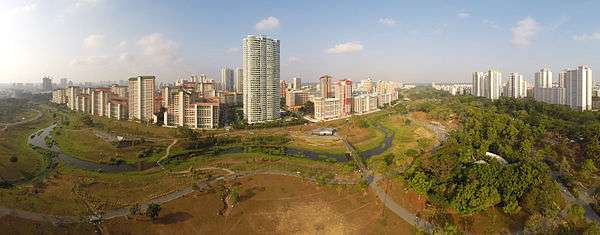 Drone shot from above the park
Drone shot from above the park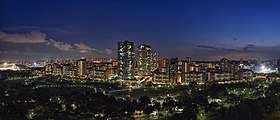 The park at night
The park at night- The park lies in the Bishan heartland
- The floodplain fills up after a rain event
References
- "URA 2014 Master Plan". Urban Redevelopment Authority.
- "$8.5 m park for Ang Mo Kio and Bishan". The Straits Times. Singapore. 14 June 1986.
- "HDB building $8.5 million Bishan Park". Business Times. Singapore. 14 June 1986.
- "Bishan Park visitors hampering work, says contractor". The Straits Times. Singapore. 10 November 1988. Retrieved 14 July 2017.
- Nurulnadiah Md Noh (13 February 2016). "Bishan 5 now Bishan 10 with new otter pups". The Straits Times.
External links
| Wikimedia Commons has media related to Bishan-Ang Mo Kio Park. |
- Atelier Dreiseitl
- CH2M Hill
- Bishan-AMK Park - National Parks Board
- Bishan Park - Public Utilities Board
- Bishan Park Opening AsiaOne News Article
- World Landscape Architect
- TreeHugger
- Landscape Architecture Magazine
- ECOWAN
